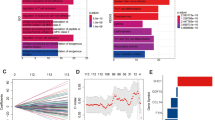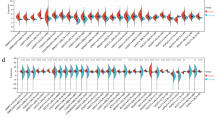Abstract
Inflammation and immune responses play important roles in cancer development and prognosis. We identified 59 upregulated inflammation- and immune-related genes (IIRGs) in clear cell renal cell carcinoma (ccRCC) from The Cancer Genome Atlas database. Among the upregulated IIRGs, nucleotide binding oligomerization domain 2 (NOD2), PYD and CARD domain (PYCARD) were also confirmed to be upregulated in the Oncomine database and in three independent GEO data sets. Tumor immune infiltration resource database analysis revealed that NOD2 and PYCARD levels were significantly positively correlated with infiltration levels of B cells, CD4+ T cells, CD8+ T cells, neutrophils, macrophages and dendritic cells. Multivariate Cox hazards regression analysis indicated that based on clinical variables (age, gender, tumor grade, pathological TNM stage), NOD2, but not PYCARD, was an independent, unfavorable ccRCC prognostic biomarker. Functional enrichment analyses (GSEA) showed that NOD2 was involved in innate immune responses, inflammatory responses, and regulation of cytokine secretion. Meanwhile, mRNA and protein levels of NOD2 were elevated in four ccRCC cell lines (786-O, ACHN, A498 and Caki-1), and its knockdown significantly inhibited IL-8 secretion, thereby inhibiting ccRCC cell proliferation and invasion. Furthermore, results showed that miR-20b-5p targeted NOD2 to alleviate NOD2-mediated IL-8 secretion. In conclusion, NOD2 is a potential prognostic biomarker for ccRCC and the miR-20b-5p/NOD2/IL-8 axis may regulate inflammation- and immune-mediated tumorigenesis in ccRCC.







Similar content being viewed by others
Availability of data and materials
The data used to support the findings of this study are available from the corresponding author upon request.
References
Siegel RL, Miller KD, Jemal A. Cancer statistics, 2019. CA Cancer J Clin. 2019;69:7–34.
Choueiri TK, Motzer RJ. Systemic therapy for metastatic renal-cell carcinoma. N Engl J Med. 2017;376:354–66.
Capitanio U, Bensalah K, Bex A, Boorjian SA, Bray F, Coleman J, Gore JL, Sun M, Wood C, Russo P. Epidemiology of renal cell carcinoma. Eur Urol. 2019;75:74–84.
Atkins MB, Tannir NM. Current and emerging therapies for first-line treatment of metastatic clear cell renal cell carcinoma. Cancer Treat Rev. 2018;70:127–37.
Tacconi EMC, Tuthill M, Protheroe A. Review of adjuvant therapies in renal cell carcinoma: evidence to date. Onco Targets Ther. 2020;13:12301–16.
Mattei J, da Silva RD, Sehrt D, Molina WR, Kim FJ. Targeted therapy in metastatic renal carcinoma. Cancer Lett. 2014;343:156–60.
Lalani AA, McGregor BA, Albiges L, Choueiri TK, Motzer R, Powles T, Wood C, Bex A. Systemic treatment of metastatic clear cell renal cell carcinoma in 2018: current paradigms, use of immunotherapy, and future directions. Eur Urol. 2019;75:100–10.
Dos Santos M, Brachet PE, Chevreau C, Joly F. Impact of targeted therapies in metastatic renal cell carcinoma on patient-reported outcomes: methodology of clinical trials and clinical benefit. Cancer Treat Rev. 2017;53:53–60.
Flippot R, Escudier B, Albiges L. Immune checkpoint inhibitors: toward new paradigms in renal cell carcinoma. Drugs. 2018;78:1443–57.
Diaz-Montero CM, Rini BI, Finke JH. The immunology of renal cell carcinoma. Nat Rev Nephrol. 2020;16:721–35.
Motzer RJ, Tannir NM, McDermott DF, Aren Frontera O, Melichar B, Choueiri TK, Plimack ER, Barthelemy P, Porta C, George S, Powles T, Donskov F, Neiman V, et al. Nivolumab plus ipilimumab versus sunitinib in advanced renal-cell carcinoma. N Engl J Med. 2018;378:1277–90.
Pan JH, Zhou H, Cooper L, Huang JL, Zhu SB, Zhao XX, Ding H, Pan YL, Rong L. LAYN is a prognostic biomarker and correlated with immune infiltrates in gastric and colon cancers. Front Immunol. 2019;10:6.
Wang F, Cao X, Yin L, Wang Q, He Z. Identification of SCARA5 gene as a potential immune-related biomarker for triple-negative breast cancer by integrated analysis. DNA Cell Biol. 2020;39:1813–24.
Koliaraki V, Prados A, Armaka M, Kollias G. The mesenchymal context in inflammation, immunity and cancer. Nat Immunol. 2020;21:974–82.
Singh R, Mishra MK, Aggarwal H. Inflammation, immunity, and cancer. Mediat Inflamm. 2017;2017:6027305.
Weber R, Groth C, Lasser S, Arkhypov I, Petrova V, Altevogt P, Utikal J, Umansky V. IL-6 as a major regulator of MDSC activity and possible target for cancer immunotherapy. Cell Immunol. 2021;359: 104254.
Im JH, Buzzelli JN, Jones K, Franchini F, Gordon-Weeks A, Markelc B, Chen J, Kim J, Cao Y, Muschel RJ. FGF2 alters macrophage polarization, tumour immunity and growth and can be targeted during radiotherapy. Nat Commun. 2020;11:4064.
Mantovani A, Ponzetta A, Inforzato A, Jaillon S. Innate immunity, inflammation and tumour progression: double-edged swords. J Intern Med. 2019;285:524–32.
Pflug KM, Sitcheran R. Targeting NF-kappaB-inducing kinase (NIK) in immunity, inflammation, and cancer. Int J Mol Sci. 2020;21:8470.
Liu Y, Li L, Li Y, Zhao X. Research progress on tumor-associated macrophages and inflammation in cervical cancer. Biomed Res Int. 2020;2020:6842963.
Luoma AM, Suo S, Williams HL, Sharova T, Sullivan K, Manos M, Bowling P, Hodi FS, Rahma O, Sullivan RJ, Boland GM, Nowak JA, Dougan SK, et al. Molecular pathways of colon inflammation induced by cancer immunotherapy. Cell. 2020;182(655–71): e22.
Fest J, Ruiter R, Mulder M, Groot Koerkamp B, Ikram MA, Stricker BH, van Eijck CHJ. The systemic immune-inflammation index is associated with an increased risk of incident cancer—a population-based cohort study. Int J Cancer. 2020;146:692–8.
Huang H, Liu Q, Zhu L, Zhang Y, Lu X, Wu Y, Liu L. Prognostic value of preoperative systemic immune-inflammation index in patients with cervical cancer. Sci Rep. 2019;9:3284.
Zhang L, Zhang B, Wei M, Xu Z, Kong W, Deng K, Xu X, Zhang L, Zetahao X, Yan L. TRIM22 inhibits endometrial cancer progression through the NOD2/NFkappaB signaling pathway and confers a favorable prognosis. Int J Oncol. 2020;56:1225–39.
Zhou Y, Hu L, Tang W, Li D, Ma L, Liu H, Zhang S, Zhang X, Dong L, Shen X, Chen S, Xue R, Zhang S. Hepatic NOD2 promotes hepatocarcinogenesis via a RIP2-mediated proinflammatory response and a novel nuclear autophagy-mediated DNA damage mechanism. J Hematol Oncol. 2021;14:9.
Velloso FJ, Sogayar MC, Correa RG. Expression and in vitro assessment of tumorigenicity for NOD1 and NOD2 receptors in breast cancer cell lines. BMC Res Notes. 2018;11:222.
Wang Y, Miao Z, Qin X, Li B, Han Y. NOD2 deficiency confers a pro-tumorigenic macrophage phenotype to promote lung adenocarcinoma progression. J Cell Mol Med. 2021;25:7545–58.
Udden SMN, Peng L, Gan JL, Shelton JM, Malter JS, Hooper LV, Zaki MH. NOD2 suppresses colorectal tumorigenesis via downregulation of the TLR pathways. Cell Rep. 2017;19:2756–70.
Liu J, He C, Xu Q, Xing C, Yuan Y. NOD2 polymorphisms associated with cancer risk: a meta-analysis. PLoS ONE. 2014;9: e89340.
Protti MP, De Monte L. Dual role of inflammasome adaptor ASC in cancer. Front Cell Dev Biol. 2020;8:40.
Deswaerte V, Nguyen P, West A, Browning AF, Yu L, Ruwanpura SM, Balic J, Livis T, Girard C, Preaudet A, Oshima H, Fung KY, Tye H, et al. Inflammasome adaptor asc suppresses apoptosis of gastric cancer cells by an IL18-mediated inflammation-independent mechanism. Cancer Res. 2018;78:1293–307.
Liang A, Zhong S, Xi B, Zhou C, Jiang X, Zhu R, Yang Y, Zhong L, Wan D. High expression of PYCARD is an independent predictor of unfavorable prognosis and chemotherapy resistance in glioma. Ann Transl Med. 2021;9:986.
Alfaro C, Sanmamed MF, Rodriguez-Ruiz ME, Teijeira A, Onate C, Gonzalez A, Ponz M, Schalper KA, Perez-Gracia JL, Melero I. Interleukin-8 in cancer pathogenesis, treatment and follow-up. Cancer Treat Rev. 2017;60:24–31.
Gonzalez-Aparicio M, Alfaro C. Significance of the IL-8 pathway for immunotherapy. Hum Vaccin Immunother. 2020;16:2312–7.
Ha H, Debnath B, Neamati N. Role of the CXCL8-CXCR1/2 axis in cancer and inflammatory diseases. Theranostics. 2017;7:1543–88.
Yuen KC, Liu LF, Gupta V, Madireddi S, Keerthivasan S, Li C, Rishipathak D, Williams P, Kadel EE 3rd, Koeppen H, Chen YJ, Modrusan Z, Grogan JL, et al. High systemic and tumor-associated IL-8 correlates with reduced clinical benefit of PD-L1 blockade. Nat Med. 2020;26:693–8.
Macfarlane LA, Murphy PR. MicroRNA: biogenesis, function and role in cancer. Curr Genom. 2010;11:537–61.
Ali Syeda Z, Langden SSS, Munkhzul C, Lee M, Song SJ. Regulatory mechanism of MicroRNA expression in cancer. Int J Mol Sci. 2020;21:1723.
Lewis BP, Burge CB, Bartel DP. Conserved seed pairing, often flanked by adenosines, indicates that thousands of human genes are microRNA targets. Cell. 2005;120:15–20.
Qi JC, Yang Z, Zhang YP, Lu BS, Yin YW, Liu KL, Xue WY, Qu CB, Li W. miR-20b-5p, TGFBR2, and E2F1 form a regulatory loop to participate in epithelial to mesenchymal transition in prostate cancer. Front Oncol. 2019;9:1535.
Yang H, Lin J, Jiang J, Ji J, Wang C, Zhang J. miR-20b-5p functions as tumor suppressor microRNA by targeting cyclinD1 in colon cancer. Cell Cycle. 2020;19:2939–54.
Liao G, Wang P, Wang Y. Identification of the prognosis value and potential mechanism of immune checkpoints in renal clear cell carcinoma microenvironment. Front Oncol. 2021;11: 720125.
Funding
This study was supported in part by the National Natural Science Foundation of China (81902593, 82002708), Hubei Province Nature Science Foundation of China (2020CFB732, 2019CFB279) and Wuhan Science and Technology Project of China (2020020601012325).
Author information
Authors and Affiliations
Contributions
Lei Lyu and Jingdong Yuan designed the experiments. Rui Min, Fuxin Zheng and Tao Huang performed the experiments. Lei Lyu and Tao Huang drafted the manuscript. Wei Xiang, Yan Feng and Chuanhua Zhang conducted data analysis and interpreted the results. Lei Lyu, Rui Min, Fuxin Zheng and Jingdong Yuan revised the manuscript. Lei Lyu, Rui Min and Fuxin Zheng contributed equally to this work as co-first authors. All authors reviewed and approved the manuscript.
Corresponding author
Ethics declarations
Conflict of interest
The authors declare no competing interests or conflict of interests.
Ethics approval and consent to participate
This study was performed in line with the principles of the Declaration of Helsinki and was approved by the Ethics Committee of Wuhan No.1 Hospital, Tongji Medical College, Huazhong University of Science and Technology (Ethics Approval Number: 2020IECA255). Informed consent was obtained from all participating patients.
Consent for publication
All authors gave consent for publication.
Additional information
Publisher's Note
Springer Nature remains neutral with regard to jurisdictional claims in published maps and institutional affiliations.
Supplementary Information
Below is the link to the electronic supplementary material.
13577_2024_1045_MOESM3_ESM.pdf
Figure S1: Box plot of the 59 upregulated IIRGs in 72 normal renal tissue samples and 537 ccRCC tissue samples. (PDF 256 kb)
13577_2024_1045_MOESM4_ESM.pdf
Figure S2: Forest map of univariate and multivariate Cox regression analysis of OS outcomes for ccRCC patients. (PDF 222 kb)
13577_2024_1045_MOESM5_ESM.pdf
Figure S3: The efficacy of individual inhibitory RNAs in down-regulating the expression of NOD2 gene was measured by qRT-PCR. **P<0.05. Data are representative expressed as the mean ± SD of each group from three independent experiments. (PDF 85 kb)
13577_2024_1045_MOESM6_ESM.pdf
Figure S4: RNA immunoprecipitation (RIP) assays were performed to assess the correlation between miR-20b-5p and NOD2 in 786-O cells and ACHN cells. (A and B) In 786-O cells, Ago2 protein expression level and relative enrichment of specific RNAs in immunoprecipitates were determined by Western blot and qRT-PCR, respectively. (C and D) In ACHN cells, Ago2 protein expression level and relative enrichment of specific RNAs in immunoprecipitates were determined by Western blot and qRT-PCR, respectively. **P<0.05. Data are representative images or expressed as the mean ± SD of each group from three independent experiments. (PDF 102 kb)
Rights and permissions
Springer Nature or its licensor (e.g. a society or other partner) holds exclusive rights to this article under a publishing agreement with the author(s) or other rightsholder(s); author self-archiving of the accepted manuscript version of this article is solely governed by the terms of such publishing agreement and applicable law.
About this article
Cite this article
Lyu, L., Min, R., Zheng, F. et al. Prognostic value of inflammation and immune-related gene NOD2 in clear cell renal cell carcinoma. Human Cell 37, 782–800 (2024). https://doi.org/10.1007/s13577-024-01045-2
Received:
Accepted:
Published:
Issue Date:
DOI: https://doi.org/10.1007/s13577-024-01045-2




